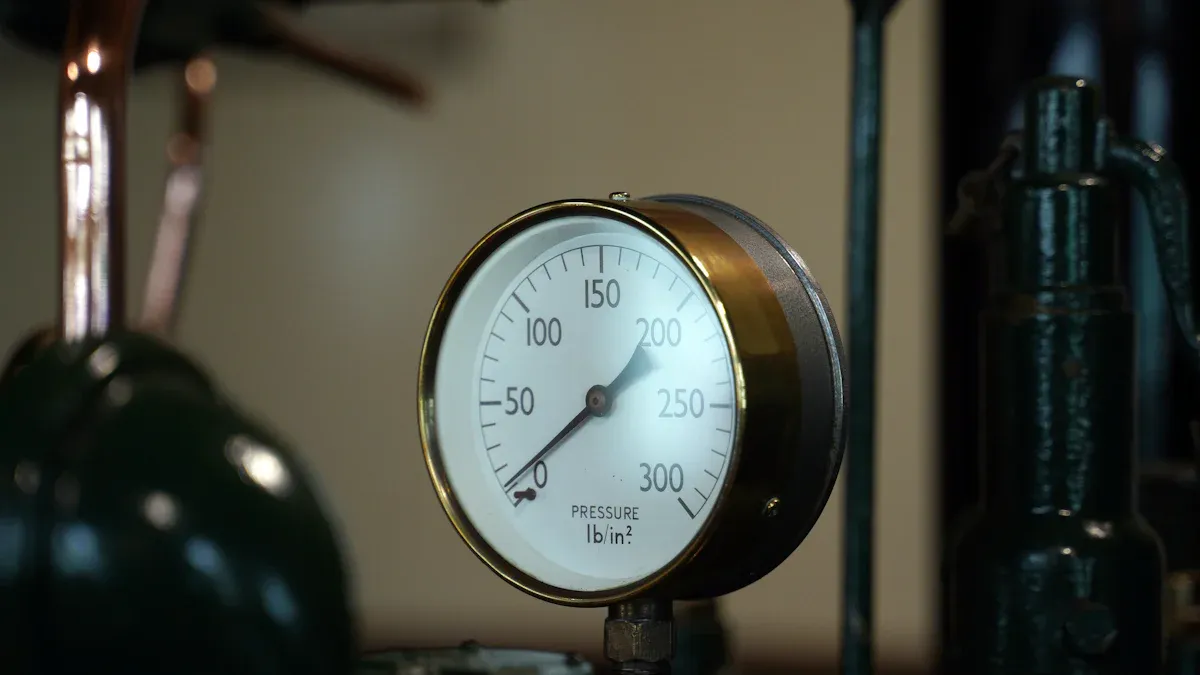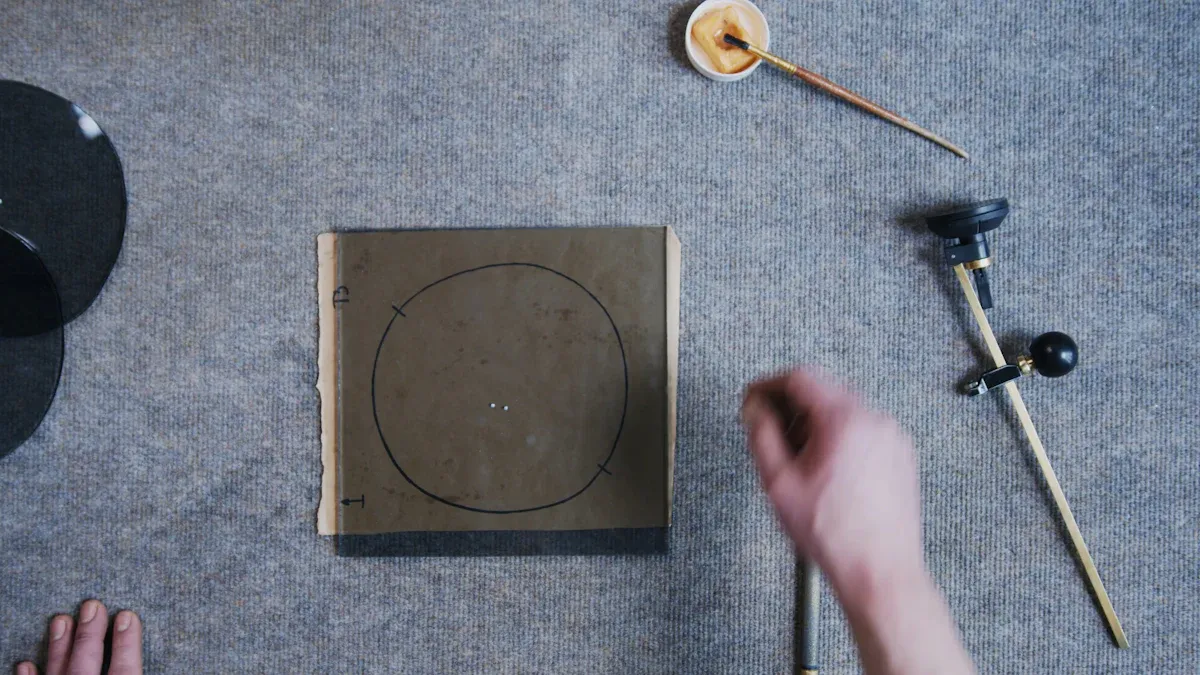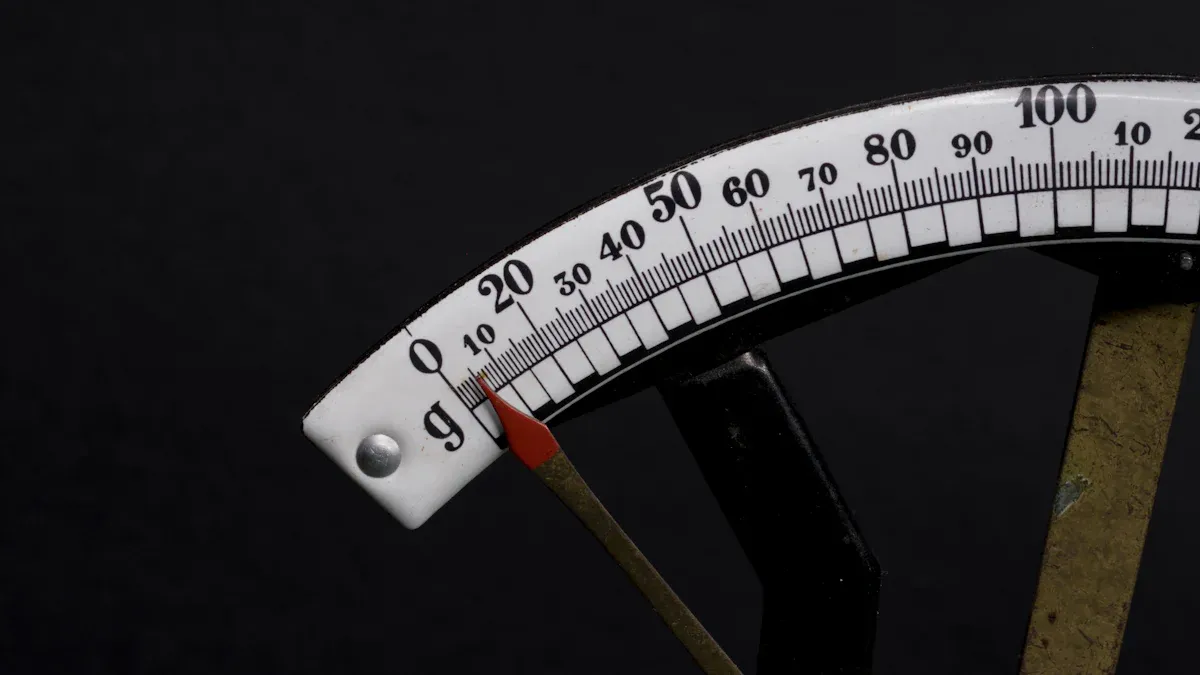Understanding the Basics of Taper and Angle Inspection

Taper and angle inspection ensures components meet precise dimensional standards. You evaluate the shape and alignment of surfaces to achieve proper fit and functionality. This process plays a critical role in the inspection of dimensions, particularly in industries like aerospace, automotive, and renewable energy.
Precision in these measurements directly impacts safety and efficiency. For instance, studies highlight that taper angle tolerances as small as ±0.069° can affect micromotion in engineering components by up to 26%. Similarly, systems with errors as minute as 16 μm demonstrate the level of accuracy required for manufacturing success.
Accurate taper and angle measurements prevent deformation and stress issues in critical parts, such as wind turbine blades, ensuring reliability.
Principles of Dimensional Inspection
Fundamental Principles
Dimensional inspection ensures that manufactured components meet precise specifications. You rely on core principles to achieve accuracy and consistency in measurements. These principles are guided by industrial standards and research-backed methodologies.
For instance, organizations like the American Society of Mechanical Engineers (ASME) and the American National Standards Institute (ANSI) establish and publish measurement standards. The table below highlights key contributors to dimensional inspection standards:
Standard Source | Description |
|---|---|
American Society of Mechanical Engineers | Establishes and writes measurement and inspection standards. |
American National Standards Institute | Publishes and sells the standards. |
H213 Special Committee | Focuses on Dimensional and Geometrical Product Specifications and Verification. |
GD&T Standards Y14.5 and Y14.100 | Standards for Geometric Dimensioning and Tolerancing. |
B89 Metrology Standards | Covers most form standards except for surface texture (B46.1). |
You also apply advanced techniques like quantitative inter-expert agreement assessments and stability analysis to validate inspection methods. These approaches ensure that the process remains reliable and adaptable to real-world manufacturing environments.
Other Considerations
Dimensional inspection involves more than just following standards. You must account for factors like material properties, environmental conditions, and tool calibration. For example, sensitivity analysis helps identify boundary conditions that could affect measurement accuracy. Cross-validation between complementary indices further enhances reliability.
Practical application is equally important. Feedback from pilot implementations in manufacturing facilities has refined inspection frameworks, making them both theoretically sound and practically effective. This ensures that your inspection processes align with industry needs while maintaining high precision.
By understanding these principles and considerations, you can perform accurate and consistent inspection of dimensions, ensuring quality and functionality in your components.
Fundamentals of Taper and Angle Inspection

What is a taper, and how is it measured?
A taper refers to a gradual reduction in the diameter or thickness of a component along its length. You encounter tapers in various applications, such as shafts, pipes, and orthopedic implants, where precise alignment and fit are critical. Measuring a taper involves determining the angle or slope of the tapered surface relative to its axis.
Several methods help you measure tapers accurately:
Blueing: This traditional method uses a master taper coated with ink to check the contact area with the workpiece. It’s a trial-and-error approach that provides visual feedback on fit.
Air Gaging: This modern technique uses air tools to measure the size and angle of tapers with high accuracy. It’s reliable and economical, making it popular in industries like automotive and aerospace.
Ring/Plug Gauges: These gauges measure standoff and functional diameter. While effective, they may not provide complete information on individual thread elements.
Statistical analysis plays a vital role in taper inspection. By taking multiple measurements across the taper region, you can evaluate mean values, standard deviations, and confidence intervals. Standards like ISO 2859 or MIL-STD-105 guide sampling plans, ensuring consistency and reliability.
Evidence Type | Description |
|---|---|
Statistical Analysis | Multiple measurements across the taper region allow for statistical evaluation, including mean, standard deviation, and confidence intervals. Sampling plans should follow standards such as ISO 2859 or MIL-STD-105. |
Case Study 1 | A steel shaft with an unintended taper caused localized stress concentration, leading to fatigue crack initiation. Corrective actions improved performance and reduced defect rates. |
Case Study 2 | A pipeline segment with excessive taper at the weld zone was traced back to inconsistent heat input during welding. Remedial measures resulted in a more uniform microstructure and reduced defects. |
Proper taper measurement ensures safety and functionality. For example, tapered fits in engines and valves prevent catastrophic failures, while accurate taper inspection in orthopedic components ensures alignment and strength.
Understanding angles and their significance in inspection
Angles play a crucial role in dimensional inspection. You measure angles to ensure components fit together correctly and function as intended. Precision angles are especially important in industries like aerospace and automotive, where even minor deviations can lead to significant issues.
In aerospace manufacturing, turbine blades require exact angle measurements to maintain aerodynamic efficiency and structural integrity. A leading manufacturer uses three-dimensional coordinate measuring machines (CMMs) to measure angles with an accuracy of up to 0.001 degrees. This level of precision allows you to detect even the smallest deviations from tolerances.
In automotive production, rigorous inspection protocols for angles reduce the risk of defects. Accurate angle measurements ensure components fit together seamlessly, enhancing vehicle safety and performance.
Key concepts: slope, degrees, and dimensions
Understanding slope, degrees, and dimensions is essential for advanced measurement applications. The slope represents the steepness or incline of a surface, while degrees quantify the angle formed between two intersecting lines or planes. Dimensions provide the physical measurements of a component, such as length, width, and height.
Research highlights the importance of observer position in slope estimation. Verbal estimates of slopes vary based on the distance and eye height of the observer. For example, when stereopsis (depth perception) is lost, observers tend to overestimate slopes by 15-25 degrees at eye level. This phenomenon underscores the need for precise measurement tools and techniques.
Accurate slope and angle measurements are vital in applications like inspection of dimensions. For instance, in oil and gas pipelines, precise taper and angle measurements prevent defects and ensure structural integrity. Similarly, in renewable energy systems, accurate dimensions and angles enhance the efficiency of wind turbine blades.
Environmental Requirements for Inspection
Temperature
Temperature plays a crucial role in ensuring accurate inspection results. You must maintain a stable temperature in the inspection environment to prevent material expansion or contraction, which can distort measurements. For example, metals expand when exposed to heat, altering their dimensions. This can lead to inaccurate readings during taper or angle inspections.
Research highlights the importance of temperature control in various fields. For instance:
Accurate temperature measurement is critical for early detection of health issues, such as fever, especially in vulnerable populations.
During health crises like the COVID-19 pandemic, temperature control helped prevent disease transmission.
Clinical trials rely on strict temperature monitoring to maintain the integrity of investigational products and ensure reliable outcomes.
By implementing rigorous temperature control protocols, you can achieve consistent and precise inspection results.
Humidity
Humidity levels also affect inspection accuracy. High humidity can cause condensation on tools and components, leading to rust or corrosion. This compromises the integrity of both the equipment and the parts being inspected. On the other hand, low humidity can create static electricity, which may interfere with sensitive electronic measuring devices.
To maintain optimal conditions, you should monitor and regulate humidity levels in the inspection area. Using dehumidifiers or humidifiers can help you achieve the ideal balance, ensuring that neither excessive moisture nor dryness impacts your measurements.
Cleanliness
Cleanliness is essential for reliable inspections. Dust, grease, or other contaminants on components can obscure defects or alter measurements. A study on aircraft engine blades revealed that cleaning the blades before inspection significantly improved defect detection rates. Inspectors were over three times more likely to identify flaws on cleaned surfaces compared to dirty ones.
You should clean all tools and components thoroughly before inspection. Establishing a routine cleaning protocol ensures that contaminants do not compromise the accuracy of your measurements. A clean environment not only enhances precision but also extends the lifespan of your equipment.
Vibration Control
Vibration can significantly impact the accuracy of taper and angle inspections. Even minor vibrations in the inspection environment can distort readings, leading to errors in measurement. You must implement effective vibration control measures to ensure precise results.
Several techniques help you manage vibrations during inspections:
Use vibration isolation systems to minimize external disturbances. These systems absorb vibrations from nearby machinery or foot traffic.
Install anti-vibration mounts or pads under inspection equipment to stabilize them.
Position inspection tools on solid, vibration-resistant surfaces like granite tables.
Modern industries rely on advanced vibration measurement techniques to maintain accuracy:
Organizations analyze vibration data to reduce equipment failure risks and improve safety. This approach enhances operational efficiency.
Resonance testing evaluates the structural integrity of components by analyzing their natural vibration frequencies. This method detects defects and ensures quality in production lines.
Sensor technologies, such as MEMS, IEPE, and piezoelectric sensors, provide precise vibration measurements. Each sensor type suits specific industrial needs, offering flexibility in various applications.
By controlling vibrations, you can achieve consistent and reliable inspection results. This ensures that your measurements meet the high standards required in industries like aerospace and automotive.
Other Factors
Other environmental factors also influence the accuracy of taper and angle inspections. You must address these elements to maintain optimal conditions:
Lighting: Proper lighting ensures you can clearly see components and tools during inspection. Use adjustable, glare-free lighting to reduce eye strain and improve visibility.
Air Quality: Dust and airborne particles can settle on components, affecting measurements. Air filtration systems help maintain a clean inspection environment.
Electromagnetic Interference (EMI): EMI from nearby electronic devices can disrupt sensitive measuring tools. Shielding inspection areas or using EMI-resistant equipment minimizes this risk.
Attention to these factors enhances the precision of your inspections. A well-controlled environment ensures that your measurements remain accurate and dependable.
Common Methods for Taper and Angle Inspection
Overview of Traditional Methods
Traditional methods for taper and angle inspection have been the foundation of dimensional measurement for decades. These methods rely on simple tools and techniques that are easy to use and widely accessible. You can use them to achieve reliable results, especially in environments where advanced technology may not be available.
One common approach involves using mechanical gauges, such as ring or plug gauges, to measure tapers. These tools provide a straightforward way to check the fit and alignment of components. For angle measurements, protractors and bevel gauges are often employed. These tools allow you to measure angles directly, making them ideal for quick inspections.
Despite their simplicity, traditional methods remain effective in many applications. For example:
Mechanical gauges are durable and require minimal maintenance.
Protractors and bevel gauges are portable and easy to use, even in tight spaces.
Advancements in inspection technology have validated the effectiveness of these methods. For instance:
Multi-sensor technology now combines traditional tools with modern systems, enabling you to measure multiple parameters, including taper, with high repeatability.
Air gages, while considered modern, build on the principles of traditional mechanical gauges. They provide quick and reliable measurements of toolholder tapers, ensuring quality in machining operations.
Traditional methods continue to play a vital role in the inspection of dimensions, especially when combined with modern advancements.
The Blueing Process for Taper Inspection
The blueing process is a classic technique used to inspect tapers. This method involves applying a thin layer of blue dye or ink to a master taper and then pressing it against the workpiece. The contact area reveals itself as the dye transfers to the surface of the workpiece.
You can use this process to visually assess the fit and alignment of the taper. A uniform transfer of dye indicates a good fit, while uneven patterns suggest misalignment or imperfections. This method is particularly useful for detecting high spots or irregularities on the tapered surface.
The blueing process offers several advantages:
It provides immediate visual feedback, allowing you to identify issues quickly.
It requires minimal equipment, making it cost-effective and easy to implement.
However, this method also has limitations. It relies heavily on the skill and experience of the inspector. Additionally, it may not provide precise numerical data, which is essential for high-precision applications.
Modern advancements have enhanced the blueing process. For example, dual-sensor autofocus methods now combine vision and tactile sensing, improving accuracy for inspecting complex surfaces. These innovations demonstrate how traditional techniques like blueing can evolve to meet the demands of modern manufacturing.
Using Trigonometric Calculations for Angle Measurement
Trigonometric calculations offer a mathematical approach to angle measurement. By applying basic trigonometric principles, you can calculate angles with high precision, even in complex geometries. This method is particularly useful when direct measurement tools, such as protractors, are impractical.
To measure an angle using trigonometry, you typically need two key dimensions: the length of one side of the angle and the height or base of the triangle formed by the angle. Using these values, you can apply formulas like:
Tangent (tan θ = opposite/adjacent)
Sine (sin θ = opposite/hypotenuse)
Cosine (cos θ = adjacent/hypotenuse)
For example, if you know the height and base of a right triangle, you can calculate the angle using the tangent function. This approach allows you to measure angles indirectly, making it ideal for inspecting components with intricate designs.
Trigonometric calculations also integrate seamlessly with modern tools. Coordinate measuring machines (CMMs) and digital protractors often use these principles to provide accurate angle measurements. Multi-sensor technology further enhances this process by combining tactile and optical measurements, ensuring high repeatability and precision.
By mastering trigonometric calculations, you can achieve a deeper understanding of angle measurement. This knowledge empowers you to tackle complex inspection challenges with confidence.
Modern tools: air gaging and digital protractors.
Modern tools like air gaging and digital protractors revolutionize taper and angle inspection. These tools combine advanced technology with user-friendly designs, enabling you to achieve precise measurements with minimal effort.
Air Gaging: Precision at Its Best
Air gaging uses compressed air to measure dimensions and angles with exceptional accuracy. This tool works by detecting variations in airflow caused by changes in the distance between the nozzle and the surface being inspected. You can rely on air gaging for consistent results, especially when inspecting tapers in high-precision applications.
Enhanced Precision: AI algorithms integrated into air gaging systems analyze airflow data to detect anomalies that might go unnoticed with traditional methods.
Adaptive Learning: Machine learning models improve the tool’s performance over time, ensuring better defect detection with each inspection.
Predictive Maintenance: Advanced systems predict potential equipment failures, helping you avoid costly downtime and maintain smooth operations.
Air gaging is ideal for industries like aerospace and automotive, where precision is non-negotiable. Its ability to provide reliable measurements makes it a preferred choice for inspecting complex geometries and tight tolerances.
Digital Protractors: Simplifying Angle Measurement
Digital protractors offer a modern solution for measuring angles. These tools display angle readings digitally, eliminating the guesswork associated with manual protractors. You can use them to measure angles quickly and accurately, even in challenging environments.
Remote Oversight: Digital protractors equipped with IoT sensors allow supervisors to monitor inspections in real time from anywhere.
Data-driven Decisions: Instant insights from digital tools help you make informed decisions during the inspection process.
System Interconnectivity: These tools integrate seamlessly with other inspection systems, enhancing coordination and efficiency.
Digital protractors are lightweight and portable, making them suitable for on-site inspections. Their ease of use ensures that even personnel with minimal training can perform accurate measurements.
Benefits of Modern Tools
Modern tools like air gaging and digital protractors offer several advantages that improve the inspection process:
Enhanced Supply Chain: These tools provide consistent measurement data, earning the trust of customers and inspectors alike.
Easy No-Code Programming: Simplified setup processes allow you to start inspections quickly without extensive training.
Reliability and Consistency: Advanced technology ensures compliance with industry standards and delivers dependable results.
By adopting these tools, you can streamline your inspection workflows, reduce errors, and achieve higher levels of precision. Their adaptability and efficiency make them indispensable in today’s manufacturing and engineering environments.
Tools and Equipment for Accurate Measurement

Vernier Calipers and Micrometers
Vernier calipers and micrometers are essential tools for precise dimensional measurements. You can use Vernier calipers to measure internal, external, and depth dimensions with an accuracy of up to 0.02 mm. Micrometers, on the other hand, excel in measuring smaller dimensions with even greater precision, often reaching accuracies of 0.01 mm.
In practical tests, the performance of various calipers was compared. The results showed that high-quality tools, like the Mitutoyo caliper, provided more consistent readings than cheaper alternatives. For example:
Type of Caliper | Thickness of Paper | PCB (2 sides copper) | PCB (No copper) |
|---|---|---|---|
Cheap digital caliper | 0.0 mm | 1.6 mm | 1.5 mm |
Plastic caliper | 0.1 mm | 1.55 mm | 1.40 mm |
Mitutoyo | 0.1 mm | 1.60 mm | 1.56 mm |
This comparison highlights the importance of choosing the right tool for accurate measurements. While Vernier calipers are versatile, micrometers are better suited for tasks requiring higher precision, such as measuring unstructured materials.
Angle Plates and Sine Bars
Angle plates and sine bars are indispensable for inspecting angles and tapers. Angle plates provide a stable reference surface, allowing you to position components accurately during inspection. Sine bars, when used with gauge blocks, enable you to measure angles with exceptional precision.
For instance, you can calculate an angle by placing the sine bar on a flat surface and adjusting the height of the gauge blocks. The angle is determined using the sine function:
sin θ = height of gauge blocks / length of sine bar
This method ensures reliable results, especially in applications requiring high accuracy. Industries like aerospace and automotive rely on these tools to maintain tight tolerances in critical components.
Optical Comparators and Coordinate Measuring Machines (CMMs)
Optical comparators and CMMs represent the pinnacle of modern measurement technology. Optical comparators project magnified images of a component onto a screen, allowing you to inspect dimensions and angles visually. This tool is ideal for detecting subtle deviations in small parts.
CMMs, on the other hand, use probes to measure the geometry of components in three dimensions. These machines offer unparalleled accuracy, often achieving tolerances within microns. In industries like semiconductor fabrication, where critical dimension measurement (CDM) is vital, CMMs ensure that products meet exact specifications. The Dimensional Measurement Services project emphasizes the role of such advanced tools in enhancing product quality and performance.
Tip: Regular calibration of these tools is crucial. A single calibration can influence numerous subsequent measurements, ensuring consistent accuracy across your inspection processes.
By leveraging these tools, you can achieve precise and reliable measurements, meeting the stringent demands of modern manufacturing.
Advantages of digital and automated tools.
Digital and automated tools have transformed the way you perform taper and angle inspections. These tools offer unmatched precision, speed, and efficiency, making them indispensable in modern manufacturing and engineering.
1. Enhanced Accuracy
Digital tools eliminate human error by providing precise measurements. Automated systems use advanced algorithms to analyze data, ensuring consistent results. For example, digital protractors display angles with an accuracy of up to 0.01 degrees. This level of precision helps you meet tight tolerances in industries like aerospace and automotive.
2. Time-Saving Features
Automated tools streamline the inspection process. You can measure multiple dimensions simultaneously, reducing the time spent on manual checks. Coordinate measuring machines (CMMs) and air gaging systems allow you to inspect complex geometries in minutes. Faster inspections mean higher productivity and lower operational costs.
3. User-Friendly Interfaces
Modern tools come with intuitive interfaces that simplify operation. Digital displays and touchscreens make it easy for you to read measurements and adjust settings. Even if you’re new to dimensional inspection, these tools help you perform accurate checks with minimal training.
Tip: Regularly update the software in your digital tools. Updates improve functionality and ensure compatibility with the latest industry standards.
4. Data Integration and Analysis
Automated systems store and analyze inspection data. You can track trends, identify defects, and generate reports effortlessly. This feature helps you make informed decisions and maintain quality control. Tools like IoT-enabled digital protractors even allow remote monitoring, giving you real-time insights into the inspection process.
5. Improved Reliability
Digital tools maintain consistent performance over time. Automated systems self-calibrate and detect anomalies, ensuring reliable measurements. This reduces the need for frequent recalibration and minimizes downtime.
🎯 Key Takeaway: Digital and automated tools enhance precision, save time, and simplify inspections. By adopting these technologies, you can improve efficiency and maintain high-quality standards in your work.
Dimensional Inspection Techniques
Inspection of Holes and Shafts
Holes and shafts are critical components in many mechanical systems. Their dimensions directly affect the fit and function of assemblies. You must inspect these features carefully to ensure they meet design specifications. Common tools for this task include plug gauges, bore gauges, and micrometers. Each tool offers unique advantages depending on the size and precision required.
For example, a plug gauge helps you quickly verify whether a hole falls within acceptable tolerances. A bore gauge, on the other hand, provides more detailed measurements of internal diameters. When inspecting shafts, you can use micrometers to measure their external dimensions with high accuracy. These tools allow you to detect deviations that could lead to misalignment or mechanical failure.
Inspection of Template Dimensions
Templates serve as reference models for manufacturing processes. Their dimensions must be accurate to ensure consistent production quality. You can inspect template dimensions using tools like optical comparators and coordinate measuring machines (CMMs). These devices allow you to compare the template against its design specifications.
Optical comparators project a magnified image of the template onto a screen, making it easier to identify discrepancies. CMMs, on the other hand, use probes to measure the template’s geometry in three dimensions. By inspecting templates thoroughly, you can prevent errors from propagating through the production line.
Indirect Measurement of Dimensions
Sometimes, direct measurement of a component isn’t feasible due to its size, shape, or location. In such cases, you can use indirect methods to determine dimensions. Trigonometric calculations, for instance, allow you to measure angles and distances based on known values. Similarly, you can use sine bars and gauge blocks to calculate angles indirectly.
Indirect methods are particularly useful in the inspection of dimensions for complex or inaccessible parts. They provide reliable results when direct tools cannot be applied. By mastering these techniques, you can expand your ability to measure a wide range of components.
Inspection of Large Dimensions
Inspecting large dimensions requires specialized tools and techniques to ensure accuracy. Components like wind turbine blades, bridge sections, or large machine parts demand precise measurements due to their critical roles in structural integrity and performance. You must approach these inspections with careful planning and the right equipment.
One effective method involves using laser trackers. These devices project a laser beam onto the component's surface and measure distances with high precision. Laser trackers are ideal for large-scale inspections because they cover extensive areas quickly. Another option is portable coordinate measuring machines (CMMs). These tools allow you to measure large components directly on the shop floor, saving time and reducing the need for transportation.
Tip: Always calibrate your tools before starting the inspection. Calibration ensures consistent and reliable results, especially for large-scale measurements.
Environmental factors like temperature and vibration can affect the accuracy of large-dimension inspections. You should control these variables by conducting inspections in stable environments. Additionally, using reference points or fiducial markers helps maintain alignment and improves measurement consistency.
By mastering these techniques, you can ensure that large components meet design specifications and perform reliably in their applications.
Inspection of Small Dimensions
Small dimensions, such as those found in microelectronics or precision-engineered parts, require a different set of tools and skills. You need to use instruments capable of measuring minute details with exceptional accuracy.
Microscopes and optical comparators are excellent for inspecting small dimensions. Microscopes provide magnified views of tiny features, allowing you to detect defects or deviations. Optical comparators project enlarged images of components, making it easier to measure intricate details. For even higher precision, you can use contact probes or non-contact laser scanners.
Note: When inspecting small dimensions, cleanliness is crucial. Dust or debris can obscure features and lead to inaccurate measurements.
You should also consider the material properties of the component. Some materials, like soft metals or plastics, may deform under pressure. In such cases, non-contact methods are preferable. By using the right tools and maintaining a clean environment, you can achieve accurate results for small-dimension inspections.
Inspection of Long Hole Diameters
Inspecting long hole diameters presents unique challenges. These features often appear in components like pipes, shafts, or aerospace parts. You need tools that can reach deep into the hole while maintaining accuracy.
Bore gauges and depth micrometers are commonly used for this purpose. Bore gauges measure the internal diameter of the hole, while depth micrometers determine its depth. For longer holes, you can use laser-based systems or ultrasonic probes. These advanced tools provide precise measurements even in hard-to-reach areas.
Callout: Ensure the tool's alignment with the hole's axis. Misalignment can lead to incorrect readings and compromise the inspection's accuracy.
You should also account for surface finish and material properties. Rough surfaces or irregularities inside the hole can affect measurements. By combining the right tools with proper techniques, you can inspect long hole diameters effectively and ensure they meet design requirements.
Challenges in Taper and Angle Inspection
Common sources of error in manual measurement
Manual measurement often introduces errors that can compromise accuracy. You might encounter issues like inconsistent pressure when using tools such as micrometers or calipers. Variations in how you hold or position the tool can also lead to discrepancies. For example, tilting a caliper even slightly can result in incorrect readings.
Another common challenge involves parallax error. This occurs when you view a scale at an angle instead of directly from above. Misreading the scale can lead to significant deviations, especially in high-precision tasks. Fatigue is another factor. Long inspection sessions can reduce focus, increasing the likelihood of mistakes.
To minimize these errors, you should practice proper handling techniques and take regular breaks. Using tools with digital displays can also help reduce reliance on manual interpretation, improving accuracy.
Material and surface finish considerations
The material and surface finish of a component can greatly affect your measurements. Materials like soft metals or plastics may deform under pressure, leading to inaccurate readings. Harder materials, on the other hand, can cause wear on your tools, reducing their precision over time.
Surface finish also plays a critical role. Rough or uneven surfaces can interfere with the contact points of your measuring tools. For instance, a micrometer may not provide accurate results if the surface has burrs or scratches.
You can address these challenges by selecting the right tools for the material and ensuring surfaces are clean and smooth before inspection. Non-contact methods, such as laser scanners, are particularly useful for delicate or irregular surfaces.
Addressing alignment and calibration issues
Alignment and calibration are essential for accurate taper and angle inspections. Misaligned tools can produce skewed results, especially when measuring angles. For example, if a sine bar is not perfectly level, the calculated angle will be incorrect.
Calibration ensures your tools provide consistent and reliable measurements. Over time, even high-quality instruments can drift out of calibration due to wear or environmental factors. Regular calibration checks help maintain their accuracy.
To address these issues, you should always verify the alignment of your tools before starting an inspection. Use calibration standards or reference blocks to confirm your instruments are functioning correctly. Maintaining a routine calibration schedule ensures your measurements remain dependable.
Practical Tips for Accurate Inspection
Ensuring proper tool calibration
Regular tool calibration is essential for maintaining accuracy in high-precision inspections. Calibration ensures your instruments perform consistently, even under varying conditions. For example, tools exposed to high usage or fluctuating environmental factors, such as temperature and humidity, may require more frequent calibration. A high-volume hematology analyzer, for instance, undergoes daily calibration to ensure reliable results.
You should also consider the purpose of calibration in quality control. It helps monitor instrument performance and ensures compliance with industry standards like Good Manufacturing Practices (GMP). Regular checks, whether daily or per batch, prevent deviations and maintain precision. By prioritizing calibration, you can avoid costly errors and ensure your measurements meet stringent quality requirements.
Factor | Description |
|---|---|
Usage Intensity | High-throughput instruments may require more frequent calibration. |
Environmental Conditions | Temperature, humidity, and vibration can affect calibration stability. |
Compliance | Calibration supports compliance with Good Laboratory Practices (GLP) and GMP. |
Best practices for handling and positioning components
Proper handling and positioning of components during inspection play a critical role in achieving accurate results. Mishandling can introduce errors or even damage sensitive parts. Always use clean, dry hands or gloves to prevent contamination. Position components on stable, vibration-free surfaces to avoid misalignment.
Standardized procedures help maintain consistency across teams. For example, developing a documentation system to record inspection results ensures traceability and reduces errors. Regular training on handling techniques also enhances skill levels and minimizes mistakes. By following these practices, you can improve the reliability of your inspections.
Use gloves to prevent contamination.
Position components on stable surfaces.
Train inspectors on proper handling techniques.
Importance of environmental factors like temperature and vibration
Environmental factors significantly impact the accuracy of inspections. Temperature fluctuations can cause materials to expand or contract, leading to distorted measurements. Similarly, vibrations from nearby machinery can interfere with sensitive tools. Maintaining a controlled environment is crucial for consistent results.
You can mitigate these issues by implementing vibration isolation systems and maintaining a stable temperature in the inspection area. Regular training on environmental controls ensures inspectors understand their importance. By addressing these factors, you can enhance the precision of your inspection of dimensions and meet industry standards.
Metric Type | Description |
|---|---|
Training Effectiveness | Metrics to measure the effectiveness of training programs and their impact on employees. |
Documentation Requirement | Regulatory requirement for documenting training, especially in regulated industries. |
Importance of regular updates on inspection techniques and standards. |
Regular training and skill development for inspectors.
Regular training and skill development are essential for maintaining accuracy and consistency in taper and angle inspections. As an inspector, you must stay updated with the latest tools, techniques, and industry standards to ensure high-quality results.
Why Training Matters
Training equips you with the knowledge to handle advanced tools and adapt to evolving inspection methods. For example, modern tools like coordinate measuring machines (CMMs) and digital protractors require specific skills to operate effectively. Without proper training, you risk errors that could compromise the quality of your measurements.
Tip: Schedule periodic training sessions to stay proficient with both traditional and modern inspection tools.
Key Areas for Skill Development
Focus on these areas to enhance your expertise:
Tool Calibration: Learn how to calibrate instruments like micrometers and sine bars to maintain accuracy.
Data Analysis: Develop skills to interpret measurement data and identify trends or anomalies.
Environmental Control: Understand how factors like temperature and vibration affect inspections and how to mitigate them.
Advanced Techniques: Master methods like trigonometric calculations and non-contact measurements for complex components.
Benefits of Ongoing Training
Continuous learning improves your efficiency and confidence. It also ensures compliance with industry standards, boosting your credibility as an inspector. A well-trained team can identify defects early, reducing rework and saving costs.
Training Type | Frequency | Example Topics |
|---|---|---|
Tool-Specific | Quarterly | Calibration, operation, maintenance |
Industry Updates | Annually | New standards, emerging technologies |
Practical Workshops | Biannually | Hands-on practice with new tools |
Callout: Encourage peer-to-peer learning by sharing insights and experiences during team meetings.
By prioritizing training and skill development, you can excel in your role and contribute to the success of your organization.
FAQ
What is the most accurate tool for measuring tapers?
The most accurate tools for measuring tapers include coordinate measuring machines (CMMs) and air gaging systems. These tools provide precise measurements, often within microns, making them ideal for high-precision applications in industries like aerospace and automotive.
Tip: Regularly calibrate these tools to maintain their accuracy over time.
How do environmental factors affect taper and angle inspections?
Environmental factors like temperature, humidity, and vibration can distort measurements. For example, temperature changes can cause material expansion or contraction. Maintaining a stable environment ensures consistent and reliable results during inspections.
Callout: Use vibration isolation systems and temperature control to minimize environmental impacts.
Can you inspect angles without advanced tools?
Yes, you can inspect angles using traditional tools like protractors, bevel gauges, or sine bars. These methods are cost-effective and reliable for basic applications. However, they may lack the precision of modern digital tools.
Note: For high-precision needs, consider upgrading to digital protractors or CMMs.
Why is tool calibration important in dimensional inspection?
Tool calibration ensures your instruments provide accurate and consistent measurements. Over time, tools can drift out of calibration due to wear or environmental factors. Regular calibration prevents errors and maintains compliance with industry standards.
Tip: Schedule routine calibration checks to avoid costly measurement inaccuracies.
What are the common challenges in inspecting small dimensions?
Inspecting small dimensions often involves challenges like tool alignment, surface cleanliness, and material deformation. Dust or debris can obscure features, while soft materials may deform under pressure. Non-contact methods, such as laser scanners, are ideal for delicate or intricate components.
Callout: Always clean components and use appropriate tools for small-dimension inspections.
See Also
Essential Tips for Choosing Measurement Instruments in Quality Assurance
Understanding Jigs and Fixtures in Manufacturing Operations
Exploring Advantages of CAE Analysis in Die Casting Design
Guide to Inspecting and Testing Die Casting Molds Pre-Production
Key Safety Tips for High-Speed Cutting Operations
About Hunan Puka
Established in 2016 and based in Hunan, China, with a liaison point in Berlin, we are a Tier 2 supplier for the automobile industry. We specialize in the production of customized aluminum die-casting parts designed for machines with a closing force ranging from 280 to 1250 tons, with subsequent manufacturing process CNC machining and surface treatment. Our commitment to quality is reflected in our accredited quality management system, certified by ISO9001:2015 and IATF16949:2016 standards.


